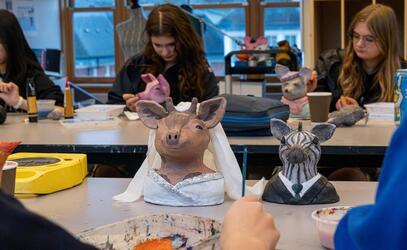Art class at the Middle School is setting new standards for what personalization can look like.
Ms. Devon Bottomley redesigned the Grade 6-8 art program this summer after being inspired to make changes to increase students' excitement and engagement in Visual Arts class.
"Specifically at the Middle School, these are the years in which they start to build autonomy with their increasing age and maturity levels. But it's also a good time as art teachers to grab them, to keep their interest in visual art and engage them in something that makes them feel confident in what they create," she says.
The new art program for all Grade 6-8 students is designed to give students choice of which materials they work with, learn at their own speed and complete open-ended, personalized art projects that inspire them, rather than prescriptive ones.
Like a Video Game
Visual Arts at the Middle School is divided into four "centres" that students get to choose from: 2D Studio, 3D Studio, Craft and Fibre Arts Studio, and Technology Studio. How each centre works is best explained by Ms. Bottomley comparing it to a video game: "Each centre is like a world in a video game. Each world has four different levels you can pass but you have to complete the first level to be able to level-up to the second level and so on... The skills you get in the earlier levels help you as you move on to the next level."
But in Ms. Bottomley's art class each level isn't a new project, it's a new (and often more challenging) material that students get to work with and the key to the Middle School art program is the word "choice". While every student must complete Level 1 in all four centres, what materials they choose for their artwork after that is entirely up to them – so long as they properly level-up to that material.
Unlike a video game, the goal isn't to complete all four worlds. The goal is to provide students access to 16 different materials so they find some that they're most interested in using. And how long it takes to complete a level doesn't matter, either.
"Students get to choose breadth and depth. One student might decide they really enjoy stop-motion animation, so they stay on the Tech Studio's first level and show growth in that area over the school year using those materials, while another student may want to use clay so they'll need to move through each level in the 3D Studio to build upon their skills to earn the ability to work with clay," she says.
The art program is not a free-for-all. There are specific skills that students must learn and demonstrate before they can level-up. Students still get report cards and there are learning outcomes they must achieve on a variety of criteria related to improving as artists and growing as learners.
Technology in the Classroom
When art class starts, students get to choose which centre they'll sit at for the day. They'll also grab an iPad or a laptop, get started on their artwork right away and work at their own pace.
"Every class they'll watch a tutorial video that takes them through the steps of what they're learning depending on their material," Ms. Bottomley says, highlighting that she's recorded many videos herself already including safety videos for using tools like hot glue guns or X-Acto knives. "It allows students the ability to pause, rewind and go back to where they need to. It's really about them learning the process as opposed to mimicking – creating something you see someone else creating."
As students learn techniques from the videos, it allows Ms. Bottomley to spend class time working one-on-one with students and checking on their individual progress.
"Each class is only 50 minutes long, so I wanted to find a way that gave them more time to do art and was less of them listening to what I had to say," she says. The impetus for change also came about as she looked for opportunities for students to develop an even greater love of art by not being forced to work with material and on projects that they may be less interested in.
Art Projects
With each student going at their own pace and choosing their own artistic path, changes have also been made to the way they do art projects.
In Term 1, students are spending time familiarizing themselves with the centres and working through as many materials as they choose to. Term 1 is about exploring, practicing and skill-building.
In Terms 2 and 3, students will finish art projects that we call "WOW Pieces". Each WOW Piece, using the material of their choosing, will be an in-depth art project based around a wider theme.
At the end of the term, instead of a full class of clay sculptures that are put on display, 16 students might use 16 different materials – from a series of photos to a colourful painting to a fabric weaving – to artistically represent the theme.
Each WOW Piece will also follow a 13-step process that involves research, sketching, planning and feedback so students take their time to thoughtfully create, share and reflect on artwork they want to do and that they're proud of making.
Engaging with Art
Ms. Bottomley says she's really happy with how this pilot program has been received so far.
"Not only is offering a breadth of materials important – of course we want our students to have a solid understanding of advanced skills and techniques as they move on to the Senior School, but having that sense of autonomy and choice really lets kids take ownership of their Visual Art class," she says. "As it turns out, I've seen a total shift in the level of engagement for some of the students who I taught before who weren't always engaged in the learning. That's been really exciting to see.
"Art should be enjoyable for each student. Like all their classes, we want students to take ownership of what it is they do rather than us pulling them along this process, willing or not," Ms. Bottomley says. "I feel like making this change is not just a reflection of what I want for the kids but also a reflection of their strengths and abilities and skills to succeed in areas that interest them."


